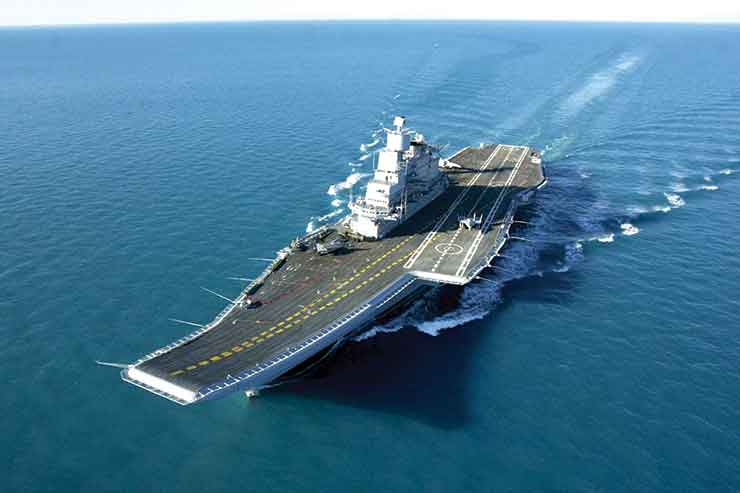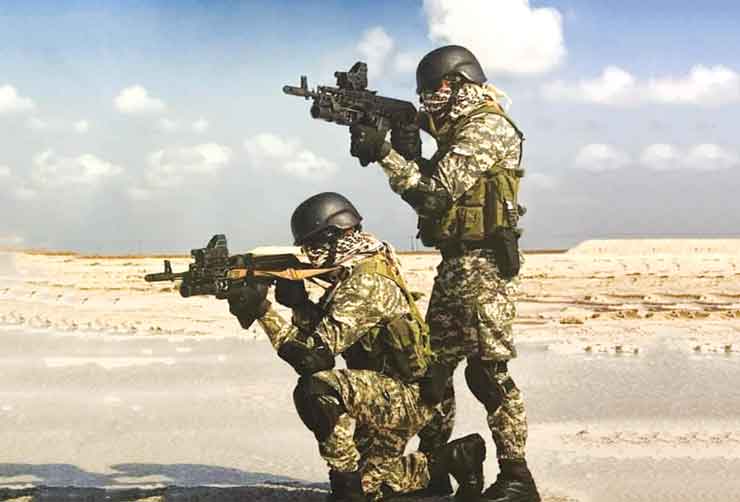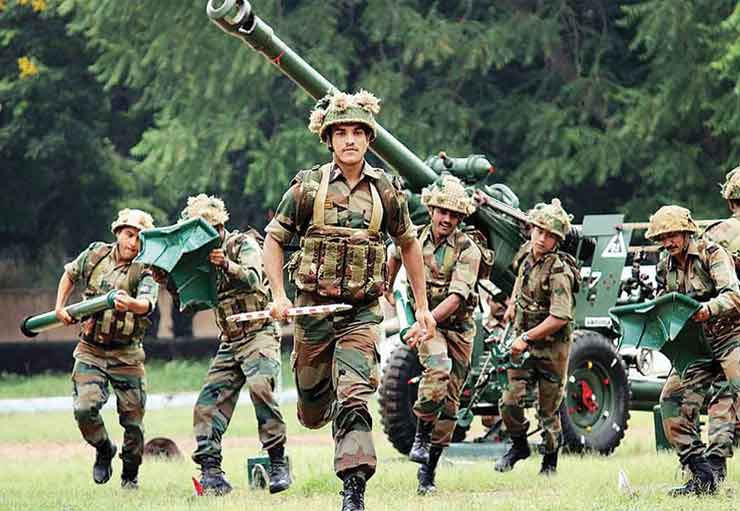
India is making significant strides in solidifying its position in the Asian age, particularly by bolstering its armed forces through a robust modernisation drive. Notable investments have been directed towards the Navy and the Air Force, with such key acquisitions as the INS Vikramaditya, INS Arihant, MMRCA, FFGA, Globe Master and Agni V&VI offering a glimpse into the future role of India’s military.
This focused effort aims at creating a credible blue-water-capable navy and an air force with continental reach, empowering India to assert its sovereignty not only in the Indian Ocean Region but also beyond. Beyond safeguarding Sea Lanes of Communications (SLoC), the armed forces are poised to extend their role to protect India’s economic interests in distant lands. In this joint endeavour, the Indian Army, particularly the infantry, will play a pivotal role, taking centre stage in addressing threats across the entire spectrum of conflicts beyond the year 2030.
THE GEOPOLITICAL LANDSCAPE
The geopolitical landscape of the 21st century is evolving towards multipolarity, with India and China emerging as key players, steering the world into the Asian age as the fastest-growing economies. As these nations transition from developing to developed status, a substantial demand is created for natural resources, serving as the catalysts for economic prowess. In the quest for securing these resources, both countries have expanded their reach beyond territorial boundaries, venturing into the unexplored realms of the African continent, the remote expanses of Central Asia and the disputed territories of South-East Asia.
Looking ahead, India’s national interests are poised to transcend traditional territorial confines, extending into non-territorial domain. The rise of China, coupled with its robust armed forces modernisation efforts against the backdrop of disputed borders with India and the challenges posed by a troubled Pakistani state, presents a formidable and ongoing challenge. The future of warfare is anticipated to be asymmetric and hybrid in nature, further complicated by the complexities of an extended neighbourhood. As India navigates these geopolitical intricacies, securing its interests becomes a multifaceted endeavour requiring strategic foresight and adaptability.
The geopolitical landscape of the 21st century is evolving towards multi-polarity, with India and China emerging as key players, steering the world into the Asian age as the fastest-growing economies
As India’s economic requirements and interests experience continuous growth, a dynamic transformation in threat perceptions and power equations is inevitable. The geographical scope of its interests will extend far beyond conventional borders, reaching as far as Antarctica in the south, Africa to the east, the Central Asian Region (CAR) in the north and the South China Sea to the south-east. Safeguarding economic interests across these diverse regions, encompassing both maritime and terrestrial domains, necessitates the formation of a joint force, prominently featuring a substantial component of the army.
THE NATURE OF FUTURE WARS
Anticipating the dynamics of future battles, it can be said that they will be characterised by brevity, fluidity, intensity and rapidity. The scale of forces involved may vary—ranging from large deployments to specialized operations executed by a select group of highly skilled soldiers. Advanced technologies will play a pivotal role and operational plans will seamlessly incorporate diverse terrains and weather conditions.
The conventional linear battlefield will give way to combat situations marked by a 360-degree threat environment, requiring forces to be agile and adaptable. Future battles are poised to be network-centric, leveraging cutting-edge technologies, including new high-tech weaponry; nuclear, biological and chemical (NBC) arsenal; and the involvement of non-state actors. The nature of warfare is expected to be hybrid, spanning the full spectrum of conflict and will prioritize the effects achieved rather than the sheer massing of forces.

CAPABILITY TO BE THREATENED?
The transformation of the Indian Army from a threat-centric force to a capability-based one, with a strategic vision extending beyond 2030, must be accelerated. In this evolution, the infantry stands as a focal point, necessitating its modernisation to align with contemporary demands. The role of the infantry will encompass a wide spectrum of responsibilities—ranging from traditional border management and counter-insurgency operations to handling internal security duties, disaster management and relief operations and participating in stabilisation efforts through bilateral and regional cooperation in areas of India’s interest.
To meet these diverse challenges, the future structure of infantry formations and units must be characterized by responsiveness and effectiveness. Infantry divisions, brigades and battalions of the future need to adopt flexible organisational frameworks that facilitate grouping and regrouping according to operational requirements. The envisioned force must embody a versatile combination of capabilities, equipped with lethal, agile, adaptable and responsive technologies and weaponry. This adaptability will be crucial in addressing the evolving nature of threats and missions anticipated in the years beyond 2030.
ROLE OF INFANTRY IN CONFLICT
In a multipolar global scenario, military strategies are increasingly influenced by a nation’s economic interests. Consequently, conflicts are anticipated to be more prevalent in the middle and lower segments of the spectrum, underscoring the crucial role of infantry in safeguarding a nation’s interests in the future. This transformation envisions specialised infantry units equipped with well-developed core competencies capable of addressing diverse segments of the threat spectrum.
This shift signifies a fundamental change from a threat-centric approach to a capability-based paradigm within the armed forces. The emphasis on versatile and adaptable infantry units reflects the strategic imperative of aligning military capabilities with the evolving geopolitical landscape and the multifaceted nature of contemporary security challenges.
STRUCTURE AND FUTURE SOLDIERS
The current paradigm of Infantry divisions in the Indian Army, characterised by fixed formations and units, is poised to undergo a significant transformation. The evolving nature of future battlefields necessitates a shift towards modular structures, turning Infantry divisions into agile and adaptable plug-and-play formations. In this new approach, divisions will be configured for specific missions, assigned a tailored combination of brigades and battalions with the requisite capabilities.
In the envisioned futuristic infantry force structure, tailored to confront 360-degree threats across the full spectrum of conflict, the infantry soldier is slated for a revolutionary transformation in both equipment and training. The future infantry soldier will embody a system within systems, characterised by effectiveness, efficiency and task-oriented capabilities. A key focus will be on accomplishing diverse tasks with economy of effort, demanding a high level of adaptability and survivability across varied terrains and climates.
This transformed infantry soldier, functioning as a system, will be designed to deliver lethality with precision and effectiveness. His capacity to maintain situational awareness and self-synchronisation will empower him to engage in coordinated and integrated battles. Within a networked environment, this heightened ability of a soldier will enable commanders not only to multitask with sub-units and units but also to enhance the effectiveness and decisiveness of individual combatants. The emphasis on this comprehensive approach aims to ensure that future infantry soldiers are well-equipped, highly skilled and seamlessly integrated into modern warfare scenarios.
In the future, the infantry will be strategically configured to execute operations seamlessly across the entire spectrum of conflict at short notice. Modernisation efforts will revolve round five cardinal principles: Lethality, Survivability, Mobility, Situation Awareness and Sustainability. These key factors will form the foundation for the optimal transformation of infantry, ensuring they are equipped to effectively navigate and succeed in a wide range of operational scenarios.

WHEN IT COMES TO LETHALITY
‘Future Soldier as System’ initiatives are currently underway in several countries, reflecting a global trend in modernizing infantry capabilities. Examples include the Land Warrior Integrated Soldier System in the USA; the IDZ in Germany; FELIN in France; FIST in the UK; and the F-InSAS programme in India. These projects aim to develop fully networked, all-terrain, all-weather personal equipment, coupled with enhanced firepower and mobility, tailored for the digitized battlefields of the future.
The future infantry is envisioned to be equipped with mission-oriented gear seamlessly integrated into the overall Command, Control, Communication, Computers, Information and Intelligence (C4I2) environment. This holistic integration extends to systems, sub-units and units, enhancing the soldier’s effectiveness in a digitized and interconnected battlefield. Such advancements are poised to significantly elevate the lethality of the infantry, transforming them into self-contained, highly capable fighting units.
The envisioned virtues of modern infantry weapons systems prioritise such attributes as light weight, modularity, lower mean time between repairs and failures (MTBR & MTBF), long range with high accuracy and desired lethality. Moreover, their ability to operate effectively in a network-centric and electronic warfare environment across the entire spectrum of conflict is deemed crucial as a decisive factor in battles.
Several futuristic trends in infantry weapons systems align with these desired attributes. Examples include SCAR-Light multiple-caliber assault rifles; the Objective Individual Combat Weapon (OICW) XM-25 featuring microchip-embedded explosive rounds for precise detonation; Metal Storm’s 36-barrelled stacked projectile machine gun; Corner Shot sideways-firing grenade launchers; disposable magazine-fed mortars with smart projectiles; Next-generation Light Anti-tank Weapon (NLAW) offering lightweight shoulder-fired anti-tank capabilities with Predicted Line of Sight (PLoS) and Over the Top Attack (OTA) and sniper rifles with extended ranges and self-correcting systems based on advanced sensors. These innovations underscore a concerted effort to equip infantry with cutting-edge technology, enhancing their firepower, adaptability and effectiveness in diverse combat scenarios.
Improving inter-operability both within the country and between the armed forces in the region is crucial. This necessitates increased military-to-military interactions at strategic, operational and tactical levels with friendly forces in the region
SO, WHAT’S THE BOTTOMLINE?
In the evolving landscape of modern warfare, robust communication and situational awareness are paramount for infantry soldiers. Effective communication from a soldier on patrol to higher commanders is facilitated by a network system that ensures connectivity even in challenging terrain where traditional communication links may be disrupted. Voice and data transmission can be relayed directly or through drone relay links, fostering seamless communication from higher headquarters to the frontline and vice versa.
To enhance situational awareness, hand-held UAVs for over-the-hill surveillance will be complemented by ground-based, all-weather surveillance devices, sensors and weather monitoring equipment. These additions to the infantry inventory will significantly contribute to overall understanding of the operational environment.
However, these advancements also come with an increased demand for electric power. Estimates suggest that the future power requirements of an infantry soldier may rise to over 10 times the current levels. To meet this escalating demand, fuel cells and fuel cell chargers are expected to play a crucial role, ensuring a sustainable and reliable power source for infantry soldiers in the days ahead.
Improving interoperability both within the country and between the armed forces in the region is crucial. This necessitates increased military-to-military interactions at strategic, operational and tactical levels with friendly forces in the region. It is essential to recognise that, in the current and potential future global multipolar order, the dynamics between military and economic power have shifted.
In the past, military power held paramount importance, while economic power was considered a luxury. However, today, economic power takes precedence and military power is essential to safeguard and assert that economic influence. The infantry’s prominence in these endeavours reflects the changing nature of global power dynamics and the strategic imperative of safeguarding economic interests in diverse and dynamic regions.
–The writer is a Defence and Aerospace Analyst. The views expressed are of the writer and do not necessarily reflect the views of Raksha Anirveda















